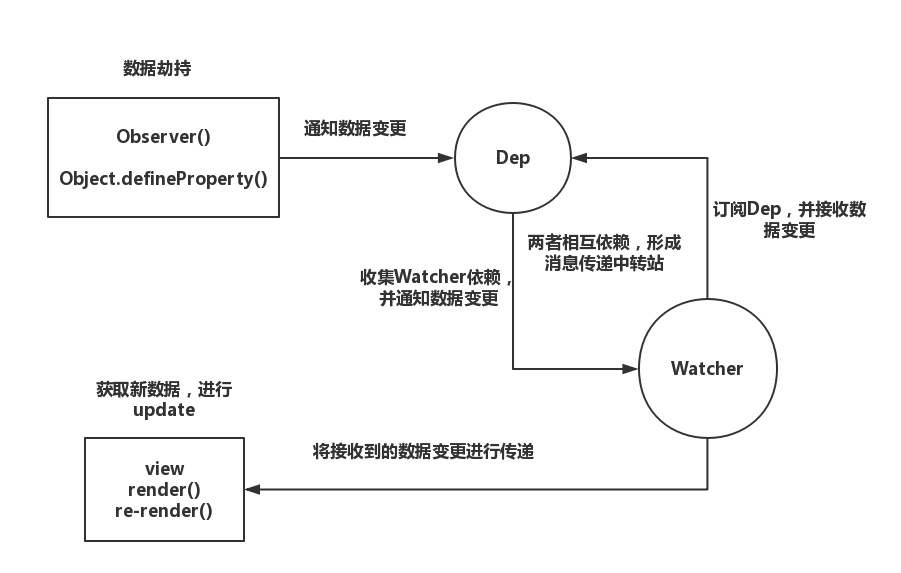在Vue2中,使用了Object.defineProterty()这个函数来实现双向绑定,这也就是为什么Vue不兼容IE8
1 响应式原理
让我们先从相应式原理开始。我们可以通过Object.defineProterty()来自定义Object的getter和setter 从而达到我们的目的。代码如下
function observe(value, cb) {
Object.keys(value).forEach((key) => defineReactive(value, key, value[key] , cb))
}
function defineReactive (obj, key, val, cb) {
Object.defineProperty(obj, key, {
enumerable: true,
configurable: true,
get: ()=>{
/*....依赖收集等....*/
/*Github:https://github.com/answershuto*/
return val
},
set:newVal=> {
val = newVal;
cb();/*订阅者收到消息的回调*/
}
})
}
class Vue {
constructor(options) {
this._data = options.data;
observe(this._data, options.render)
}
}
let app = new Vue({
el: '#app',
data: {
text: 'text',
text2: 'text2'
},
render(){
console.log("render");
}
})
通过observe函数对app.data上的每一个key和value都设定getter和setter。当value改变的时候触发setter,就会触发render这个函数。响应式的目的就达成,如果是视图更新的话我们通过监听dom的input事件来触发数据更新
但是现在我们只有在改变vue._data.text的时候才会触发他们的setter,但是我想偷懒,只改变vue.text就能触发到setter怎么做呢?
我们使用代理的方法
_proxy.call(this, options.data);/*构造函数中*/
/*代理*/
function _proxy (data) {
const that = this;
Object.keys(data).forEach(key => {
Object.defineProperty(that, key, {
configurable: true,
enumerable: true,
get: function proxyGetter () {
return that._data[key];
},
set: function proxySetter (val) {
that._data[key] = val;
}
})
});
}
依赖收集
让我们再来看看下面的代码
new Vue({
template:
`<div>
<span>text1:</span> {{text1}}
<span>text2:</span> {{text2}}
<div>`,
data: {
text1: 'text1',
text2: 'text2',
text3: 'text3'
}
});
当你的text3变化的时候,实际上text3并没有被渲染,但是也会触发一次render函数,这显然是不对的。所以我们需要收集依赖。
我们只需要在初始化的时候渲染一遍,那所有渲染所依赖的数据都会被触发getter,这时候我们只要把这个数据放到一个列表里就好啦!
我们先来认识一下Dep(dependencies)这个类,下图是一个最简单的Dep类。我们可以把他理解为发布者(这点很重要!!)
class Dep {
constructor () {
this.subs = [];
}
addSub (sub: Watcher) {
this.subs.push(sub)
}
removeSub (sub: Watcher) {
remove(this.subs, sub)
}
/*Github:https://github.com/answershuto*/
notify () {
// stabilize the subscriber list first
const subs = this.subs.slice()
for (let i = 0, l = subs.length; i < l; i++) {
subs[i].update()
}
}
}
function remove (arr, item) {
if (arr.length) {
const index = arr.indexOf(item)
if (index > -1) {
return arr.splice(index, 1)
}
}
我们每次触发getter的时候,只要把触发的对象放到dep.sub里面就好啦!
但是现在问题来了,我们用什么来装这个触发的’对象’,也可以说式订阅者呢?
我们使用Watcher这个类
class Watcher {
constructor (vm, expOrFn, cb, options) {
this.cb = cb;
this.vm = vm;
/*在这里将观察者本身赋值给全局的target,只有被target标记过的才会进行依赖收集*/
Dep.target = this;
/*Github:https://github.com/answershuto*/
/*触发渲染操作进行依赖收集*/
this.cb.call(this.vm);
}
update () {
this.cb.call(this.vm);
}
}
vm即是vue实例, expOrFn就是{{a+b}}里面的a+b, cb就是回调函数就是return a+b, options是一些配置项。
Vue在第一次渲染列表的时候如果碰到{{xxx}}这样的表达式,就会new Watcher()。解析里面的函数,然后把当前的watcher实例赋给Dep.target(Dep.target是全局的,一次性只能有一个存在,因为Vue一次只处理一个依赖)。然后执行回调函数。(这里看似是执行回调函数渲染,其实又触发了一次getter,然后就会把当前的依赖添加到sub里去)
接下来开始依赖收集
class Vue {
constructor(options) {
this._data = options.data;
observer(this._data, options.render);
let watcher = new Watcher(this, );
}
}
function defineReactive (obj, key, val, cb) {
/*在闭包内存储一个Dep对象*/
const dep = new Dep();
Object.defineProperty(obj, key, {
enumerable: true,
configurable: true,
get: ()=>{
if (Dep.target) {
/*Watcher对象存在全局的Dep.target中*/
dep.addSub(Dep.target);
}
},
set:newVal=> {
/*只有之前addSub中的函数才会触发*/
dep.notify();
}
})
}
Dep.target = null; //防止依赖重复添加
这儿我们通过示例来讲解
<template>
<div>
{{a+b}}
</div>
<div>
{{a-c}}
</div>
</template>
<script>
let app = new Vue( {
data :{
a: 1,
b: 2,
c: 3
}
})
我们编译到{{a+b}},会去实例化一个对应的Watcher对象,Watcher的构造函数中有这么一句
this.cb.call(this.vm);this.cb指的是function(){return a+b};this.vm指的是这个vue对象,这样就会触发vue.a和vue.b的getter方法,a,b都有自己的dep对象,我们通过Dep.target将这个Watcher对象就加到dep的subs数组中去了,当我们变更a或者b是就会触发setter,进而触发subs数组中的update方法,视图中的a+b就会更新
有个小知识点:我们新建一个属性对象时必须通过Vue.set的方法去实现,而不能直接通过=实现,这样会检测不到,因为我们在初始化时就通过defineProperty重构了这个对象属性的getter和setter方法,新建的属性则没有所以不会被检测到
下图为Vue框架在数据初始化中使用观察者模式的示意图:
参考文档
共同学习,写下你的评论
评论加载中...
作者其他优质文章






